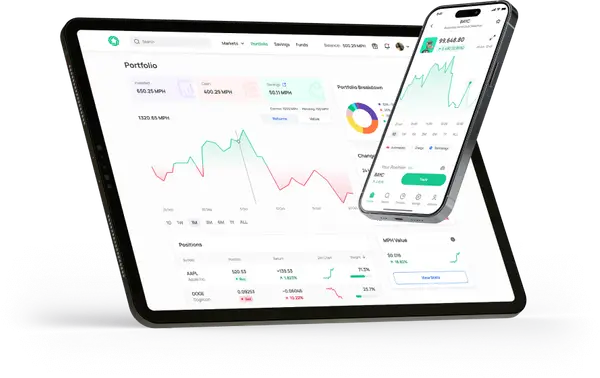Understanding Cloud Banking: Benefits, Challenges, and Innovations

Cloud banking has revolutionized the way financial institutions operate. With its numerous benefits and innovative features, it's no wonder that more and more banks are embracing this technology. In this ultimate guide, I will provide you with a comprehensive overview of cloud banking, including its definition, evolution, benefits, key features, and risks. So, let's dive right in.
Understanding Cloud Banking
Definition and Basics of Cloud Banking
Cloud banking, also known as banking as a service (BaaS), involves the delivery of banking services through cloud computing. It allows banks to move their operations to off-premises servers, managed by third-party providers. Essentially, all banking services, including transaction processing, customer data management, and security measures, are hosted and managed on the cloud.
Cloud banking offers a flexible and scalable infrastructure, eliminating the need for banks to invest heavily in hardware and software. By leveraging the cloud, banks can streamline their operations, reduce costs, and enhance efficiency.
Moreover, cloud banking enables banks to adapt quickly to changing market demands and regulatory requirements. The agility provided by cloud technology allows financial institutions to innovate rapidly and launch new services to meet customer needs.
The Evolution of Cloud Banking
The concept of cloud banking has evolved over the years. Initially, banks relied on traditional on-premises infrastructure, which required extensive maintenance and limited scalability. However, with technological advancements, banks started exploring the potential of the cloud.
Today, cloud banking has become a game-changer for the financial industry. It has revolutionized processes such as online banking, mobile banking, and digital payments. Banks can now provide their customers with seamless and secure access to their accounts from anywhere in the world.
Furthermore, the adoption of cloud banking has paved the way for enhanced data analytics and personalized services. Banks can leverage big data and machine learning algorithms to gain valuable insights into customer behavior and preferences. This, in turn, allows them to offer tailored products and services, creating a more personalized banking experience for their customers.
The Benefits of Cloud Banking
Cost Efficiency in Cloud Banking
One of the primary advantages of cloud banking is its cost efficiency. By migrating to the cloud, banks can significantly reduce their infrastructure costs. They no longer need to invest in expensive hardware or maintain complex data centers. Instead, they can rely on the cloud provider's infrastructure, paying only for the resources they use.
Additionally, cloud banking enables banks to eliminate the costs associated with software updates and maintenance. Cloud providers handle these tasks, allowing banks to focus on their core competencies.
But let's dive deeper into the cost efficiency aspect. By leveraging the cloud, banks can also benefit from economies of scale. Cloud providers serve multiple clients, pooling their resources and spreading the costs across a larger user base. This shared infrastructure model allows banks to enjoy cost savings that would be difficult to achieve on their own.
Accessibility and Convenience
Cloud banking provides customers with unprecedented accessibility and convenience. With a stable internet connection, customers can access their accounts anytime, anywhere, using multiple devices such as smartphones, tablets, or laptops. This flexibility empowers customers to manage their finances on their own terms, enhancing their overall banking experience.
Furthermore, cloud banking allows banks to offer innovative services such as real-time balance updates, instant fund transfers, and personalized financial management tools. This level of convenience not only improves customer satisfaction but also increases customer loyalty.
But let's explore the convenience aspect further. Imagine a scenario where a customer is traveling abroad and needs to make an urgent transaction. With traditional banking, this could be a cumbersome process involving multiple phone calls and paperwork. However, with cloud banking, the customer can simply log into their account using their smartphone and complete the transaction within seconds. This level of convenience not only saves time but also reduces stress for the customer.
Enhanced Security Measures
Contrary to popular belief, cloud banking offers robust security measures to protect customer data. Cloud providers invest heavily in state-of-the-art security technologies, including data encryption, multi-factor authentication, and strict access controls. These measures ensure the confidentiality, integrity, and availability of customer information.
Moreover, cloud providers adhere to stringent compliance standards, such as the General Data Protection Regulation (GDPR) and Payment Card Industry Data Security Standard (PCI DSS). This ensures that banks' customer data is handled securely and in accordance with regulatory requirements.
But let's delve deeper into the security measures aspect. Cloud providers employ a team of dedicated security experts who constantly monitor and analyze potential threats. They proactively identify vulnerabilities and implement necessary patches and updates to ensure the highest level of security. This level of expertise and continuous monitoring provides banks with peace of mind, knowing that their customers' data is in safe hands.
Key Features of Cloud Banking
Real-Time Data Synchronization
Cloud banking enables real-time data synchronization, ensuring that all account information is up-to-date and accurate. Banks no longer need to rely on batch processing or manual updates, which can lead to delays and errors. With real-time synchronization, customers can view the most current information regarding their transactions, balances, and statements.
Customization and Scalability
Cloud banking provides banks with the ability to customize their offerings to meet the unique needs of their customers. Banks can easily add or remove services and features, tailoring their offerings to target specific customer segments. This flexibility allows banks to adapt to changing market demands and stay ahead of their competitors.
Furthermore, cloud banking offers scalability, allowing banks to effortlessly handle fluctuations in demand. Banks can quickly scale their resources up or down, ensuring optimal performance and customer satisfaction.
Integration Capabilities
Cloud banking seamlessly integrates with other digital platforms and services, enabling banks to provide a comprehensive banking experience to their customers. Banks can integrate cloud banking with mobile banking apps, payment gateways, and customer relationship management (CRM) systems. This integration ensures a seamless flow of information and a unified experience for customers across different platforms.
Risks and Challenges in Cloud Banking
Data Privacy Concerns
While cloud banking offers numerous benefits, it also poses potential risks, particularly concerning data privacy. Banks must carefully select reputable cloud providers that prioritize data security. Additionally, it is crucial for banks to implement robust encryption and access control measures to safeguard customer data from unauthorized access.
Regulatory Compliance
Banks must also comply with various regulations when adopting cloud banking. They need to ensure that their cloud providers adhere to international data protection laws and industry-specific compliance standards. Moreover, banks should establish clear protocols for data handling, breach notifications, and disaster recovery to meet regulatory requirements.
Potential Technical Issues
As with any technology, cloud banking may encounter occasional technical issues such as system downtime or connectivity problems. Banks must have contingency plans in place to mitigate the impact of such issues on their operations and customer service. A reliable disaster recovery plan and efficient technical support are essential for banks to maintain customer trust and confidence.
Personal Advice: Throughout my years of experience in cloud banking, I have witnessed the remarkable transformations it has brought to the financial industry. However, while the benefits are undeniable, it is crucial for banks to approach cloud banking implementation with proper due diligence. Selecting a reputable cloud provider, ensuring data privacy, and maintaining regulatory compliance are vital steps to ensuring a successful and secure cloud banking journey.
How Does Morpher Differ?
Morpher, on the other hand, is rooted in the principles of decentralization. Built on blockchain technology, Morpher aims to democratize access to trading and investment opportunities by eliminating intermediaries. This decentralized approach empowers users by giving them direct control over their assets, reducing reliance on centralized entities, and increasing transparency. Morpher’s mission aligns with the broader DeFi movement, which seeks to create a more open and accessible financial system for all.

Key Differences
-
Centralization vs. Decentralization: Cloud banking modernizes traditional finance but keeps the centralized control with institutions. Morpher decentralizes finance, distributing control across a network and empowering individual users.
-
Technology Focus: Cloud banking leverages cloud computing to optimize existing systems, while Morpher uses blockchain to build a new, decentralized financial ecosystem.
-
User Impact: Cloud banking improves the efficiency of centralized systems, but Morpher’s decentralized model offers greater autonomy and transparency for users.
FAQs
Q: What is cloud banking?
A: Cloud banking, also known as banking as a service (BaaS), is the delivery of banking services through cloud computing. It allows banks to move their operations to off-premises servers, managed by third-party providers.
Q: What are the benefits of cloud banking?
A: Cloud banking offers cost efficiency, accessibility, convenience, enhanced security measures, real-time data synchronization, customization and scalability, and integration capabilities.
Q: What are the risks and challenges in cloud banking?
A: Risks and challenges in cloud banking include data privacy concerns, regulatory compliance, and potential technical issues.
In conclusion, cloud banking is revolutionizing the financial industry by providing banks with cost efficiency, accessibility, enhanced security, and innovative features. As with any technology, it is essential to address the risks and challenges associated with cloud banking. By carefully selecting cloud providers, ensuring data privacy, and complying with regulations, banks can embark on a successful cloud banking journey. Embracing the power of the cloud will enable banks to meet customer expectations, stay competitive, and drive digital transformation in the banking sector.
As you consider the future of banking and the transformative power of cloud technology, why not take your investment strategy to the next level with Morpher? Embrace the innovation that Morpher.com offers, from zero fees and infinite liquidity to the flexibility of fractional investing and short selling. With the Morpher Wallet, you gain unparalleled safety and control over your investments, and with up to 10x leverage, your trading potential is magnified. Experience the unique trading opportunities provided by a platform built on the Ethereum Blockchain. Sign Up and Get Your Free Sign Up Bonus today to join the revolution in global trading with Morpher.

Disclaimer: All investments involve risk, and the past performance of a security, industry, sector, market, financial product, trading strategy, or individual’s trading does not guarantee future results or returns. Investors are fully responsible for any investment decisions they make. Such decisions should be based solely on an evaluation of their financial circumstances, investment objectives, risk tolerance, and liquidity needs. This post does not constitute investment advice.

Painless trading for everyone
Hundreds of markets all in one place - Apple, Bitcoin, Gold, Watches, NFTs, Sneakers and so much more.

Painless trading for everyone
Hundreds of markets all in one place - Apple, Bitcoin, Gold, Watches, NFTs, Sneakers and so much more.









